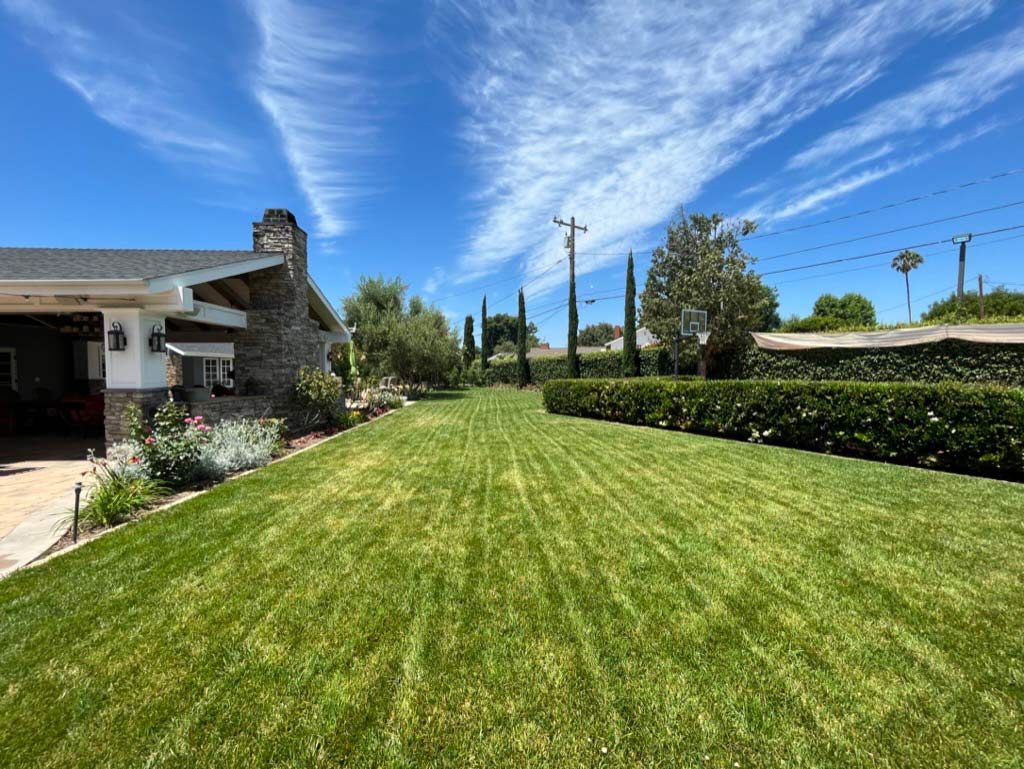Are you thinking of adding a lawn to your Southern California yard but not sure whether to install synthetic turf or sod grass? Both are great options, but with very different sets of pros and cons. Here are a few points to consider when making your decision: we compare each of these materials’ initial costs, required maintenance, and environmental impact.

Initial Cost
The cost of grass sod is much less to purchase and install compared to synthetic turf. Synthetic turf is manufactured and made from artificial fibers such as nylon, polypropylene, or polyethylene. Grass sod is naturally grown and harvested, providing for a much more affordable purchase price. While prices can vary, turf generally costs somewhere between 5 to 20 times the price of sod.
Maintenance
The primary benefit of turf is its low maintenance requirement. Once it is purchased and installed, there is minimal maintenance necessary, and your lawn can be enjoyed by pets, kids, and friends with no worry of wear and damage. Artificial turf does require consistent sanitizing (if used by pets) and/or re-sanding and brushing to avoid compacting of fibers.
Sod, however, has a much higher risk of damage and requires significantly more upkeep than turf. Overuse or extreme weather conditions may stress out the grass and lead to damage, which takes a lot of work and time to repair. Sod lawn also requires consistent trimming, fertilizing and weeding to promote and keep a healthy lawn.
Environmental Impact
Sod and artificial turf lawns have different environmental impacts, and the choice between them depends on various factors, including your priorities and local conditions. Here’s a comparison of their environmental impacts:
Water Usage: Sod lawns typically require regular watering to establish and maintain healthy grass. Once established, the water requirements can vary depending on the type of grass and local climate. In some regions, maintaining a sod lawn can be water-intensive, particularly in areas prone to drought.
Artificial turf requires little to no water once installed, which can be an advantage in water-scarce regions. However, artificial turf can become hot in direct sunlight, which may necessitate periodic cooling with water to make it safe for use, especially in very hot climates.
Chemical Use: Some sod farms may use pesticides and fertilizers to maintain the quality of their sod, which can contribute to pollution and harm local ecosystems if not managed properly. Artificial turf does not require pesticides or fertilizers, reducing the need for chemical inputs compared to those needed for natural grass.
Biodiversity: Sod lawns are typically monocultures, consisting of a single species of grass. This lack of biodiversity can negatively impact local wildlife and insects. Artificial turf provides no habitat for local wildlife or insects. It’s essentially an artificial surface with no ecological value.
In addition, artificial turf may have negative environmental impacts, depending on the application:
Heat Island Effect: Artificial turf can contribute to the urban heat island effect, as it can become very hot in direct sunlight, increasing local temperatures.
End-of-Life Disposal: Artificial turf has a limited lifespan, and when it reaches the end of its usable life, it can be challenging to dispose of responsibly, often ending up in landfills.
The choice between sod lawn and artificial turf is a very personal one, specific to your home and long-term goals. Whichever you select, the addition of a green space to your yard can bring a bright and inviting environment to your outdoor living space – one that can be enjoyed for many years.
